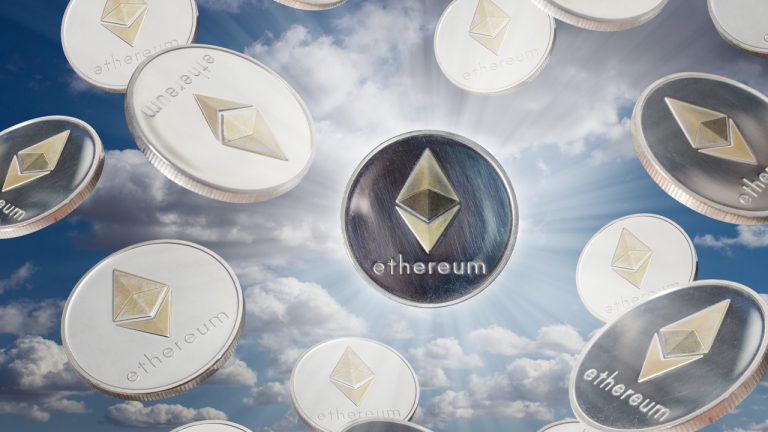
Ethereum's Trading Range and Market Influence
Ethereum's trading session today started with the cryptocurrency moving between $2,480 and $2,532, staying within a daily range of $2,472 to $2,544. This narrow range suggests a period of consolidation and stability following recent market swings. With a market capitalization of $305 billion and a significant trade volume of $18.11 billion, Ethereum continues to hold a strong position in the market, especially after the recent endorsement of 11 spot bitcoin exchange-traded funds.
Technical Indicators and Market Outlook
Examining the technical indicators on Monday, we observe a mixed perspective. The relative strength index (RSI) at 60.6 indicates a neutral to bullish outlook. Similarly, the Stochastic at 69.8, the commodity channel index (CCI) at 92.0, and the average directional index (ADI) at 19.1 all suggest a neutral market sentiment. However, the awesome oscillator at 241.3 and the moving average convergence/divergence (MACD) at 78.8 point towards a positive market trend, potentially indicating an underlying bullish drive.
Moving Averages and Bullish Trend
The moving averages (MAs) also support a bullish sentiment in the Ethereum market. The exponential moving average (EMA) and simple moving average (SMA) across various time frames (10, 20, 30, 50, 100, 200) consistently show an upward market trend, highlighting a strong recent bullish trajectory. Notably, the shorter duration EMAs surpass their SMA counterparts, indicating a rapid adaptation to recent price shifts and reinforcing the bullish trend.
Ethereum's Price Pattern and Cautionary Considerations
Looking at Ethereum's daily chart, we can observe a clear ascending pattern characterized by progressive price increases and higher lows. This pattern signifies a consistent positive trend in ETH markets. However, the significant drop on Jan. 11, followed by a rebound on Jan. 12, suggests a possible recalibration or stabilization after a notable upward movement. Traders are advised to exercise caution and consider reassessing the bullish trajectory.
Hourly Chart and Short-Term Trading
An in-depth analysis of Ethereum's price dynamics can be observed on the hourly chart. This chart reveals a recent upward trend, marked by successive higher highs and lows, albeit with notable fluctuations since Jan. 11, 2024. These hourly changes highlight the importance of precise timing for entering and exiting trades in short-term trading, especially given the clear volatility.
Medium-Term Trend and Recovery
Zooming out to the 4-hour chart, which smooths out the hourly variations, a more coherent view of Ethereum's medium-term trend can be observed. This chart showcases Ethereum's current resilience, as evidenced by its recovery from recent dips. This recovery suggests a potentially favorable moment for market entry, particularly if the price demonstrates signs of a bullish continuation pattern or bounces off key moving averages or trendline support. However, traders should remain vigilant for any indications of a weakening trend.
Bullish and Bearish Outlook
Based on the data from the 1-hour, 4-hour, and daily charts on Jan. 15, 2024, Ethereum's market sentiment appears robustly bullish. The combination of sustained buying pressure, indicated by moving averages and oscillators, along with a stable market capitalization, points towards an upward trajectory for Ethereum.
Conversely, a bearish perspective might approach the same data with caution. Despite the bullish indicators, the narrow trading range and the neutral stance of certain oscillators could suggest potential market saturation or an upcoming correction. Traders with a bearish outlook on ETH may interpret this as a signal for potential profit-taking or asset reallocation, anticipating a possible downturn or stagnation in Ethereum's price in the near future.
What are your thoughts on Ethereum's market action on Monday morning? Share your opinions in the comments section below.
Frequently Asked Questions
Should You Invest Gold in Retirement?
How much money you have saved, and whether or not gold was an option when you first started saving will determine the answer. You can invest in both options if you aren't sure which option is best for you.
In addition to being a safe investment, gold also offers potential returns. Retirement investors will find gold a worthy investment.
While most investments offer fixed rates of return, gold tends to fluctuate. Its value fluctuates over time.
However, it doesn't necessarily mean that you shouldn't invest your money in gold. You should just factor the fluctuations into any overall portfolio.
Another benefit to gold is its tangible value. Gold is much easier to store than bonds and stocks. It can also be carried.
You can always access gold as long your place it safe. Plus, there are no storage fees associated with holding physical gold.
Investing in gold can help protect against inflation. It's a great way to hedge against rising prices, as gold prices tend to increase along with other commodities.
Additionally, it will be a benefit to have some of your savings invested into something that won't lose value. Gold rises in the face of a falling stock market.
Another advantage to investing in gold is the ability to sell it whenever you wish. You can easily liquidate your investment, just as with stocks. You don't even have to wait until you retire.
If you do decide to invest in gold, make sure to diversify your holdings. You shouldn't try to put all of your eggs into one basket.
Also, don't buy too much at once. Start with a few ounces. Add more as you're able.
Remember, the goal here isn't to get rich quickly. Instead, the goal is to accumulate enough wealth that you don't have to rely on Social Security.
And while gold might not be the best investment for everyone, it could be a great supplement to any retirement plan.
What should I pay into my Roth IRA
Roth IRAs let you save tax on retirement by allowing you to deposit your own money. These accounts cannot be withdrawn until you turn 59 1/2. There are some rules that you need to keep in mind if you want to withdraw funds from these accounts before you reach 59 1/2. First, your principal (the original deposit amount) cannot be touched. No matter how much money you contribute, you cannot take out more than was originally deposited to the account. If you wish to withdraw more than you originally contributed, you will have to pay taxes.
The second rule says that you cannot withdraw your earnings without paying income tax. Also, taxes will be due on any earnings you take. Consider, for instance, that you contribute $5,000 per year to your Roth IRA. Let's further assume you earn $10,000 annually after contributing. This would mean that you would have to pay $3,500 in federal income tax. That leaves you with only $6,500 left. The amount you can withdraw is limited to the original contribution.
Therefore, even if you take $4,000 out of your earnings you still owe taxes on $1,500. On top of that, you'd lose half of the earnings you had taken out because they would be taxed again at 50% (half of 40%). You only got back $4,000. Even though you were able to withdraw $7,000 from your Roth IRA,
There are two types if Roth IRAs: Roth and Traditional. Traditional IRAs allow for pre-tax deductions from your taxable earnings. Your traditional IRA allows you to withdraw your entire contribution plus any interest. There is no limit on how much you can withdraw from a traditional IRA.
A Roth IRA doesn't allow you to deduct your contributions. Once you are retired, however, you may withdraw all of your contributions plus accrued interest. There is no minimum withdrawal requirement, unlike traditional IRAs. Your contribution can be withdrawn at any age, not just when you reach 70 1/2.
Should you open a Precious Metal IRA
It is essential to be aware of the fact that precious metals do not have insurance coverage before opening an IRA. There are no ways to recover the money you lost in an investment. This includes any loss of investments from theft, fire, flood or other circumstances.
This type of loss can be avoided by investing in physical silver and gold coins. These items are timeless and have a lifetime value. If you were to sell them today, you would likely receive more than what you paid for them when they were first minted.
If you decide to open an IRA account, choose a reputable company that offers competitive rates and products. It's also wise to consider using a third-party custodian who will keep your assets safe while giving you access to them anytime.
Remember that you will not see any returns unless you are retired if you open an Account. So, don't forget about the future!
What's the advantage of a Gold IRA?
The benefits of a gold IRA are many. It can be used to diversify portfolios and is an investment vehicle. You decide how much money is put in each account and when it is withdrawn.
Another option is to rollover funds from another retirement account into a IRA with gold. This makes for an easy transition if you decide to retire early.
The best thing about investing in gold IRAs is that you don’t need any special skills. They are offered by most banks and brokerage companies. Withdrawals are made automatically without having to worry about fees or penalties.
There are also drawbacks. Gold is known for being volatile in the past. So it's essential to understand why you're investing in gold. Are you looking for growth or safety? Are you trying to find safety or growth? Only by knowing the answer, you will be able to make an informed choice.
If you plan to keep your gold IRA indefinitely, you'll probably want to consider buying more than one ounce of gold. You won't need to buy more than one ounce of gold to cover all your needs. You may need several ounces, depending on what you intend to do with your precious gold.
You don’t necessarily need a lot if you’re looking to sell your gold. Even one ounce is enough. But you won't be able to buy anything else with those funds.
How to Open a Precious Metal IRA
First, you must decide if your Individual Retirement Account (IRA) is what you want. Once you have decided to open an Individual Retirement Account (IRA), you will need to complete Form 806. Next, fill out Form 5204. This will determine the type of IRA that you are eligible for. You must complete this form within 60 days of opening your account. After this, you are ready to start investing. You could also opt to make a contribution directly from your paycheck by using payroll deduction.
For a Roth IRA you will need to complete Form 8903. Otherwise, the process is identical to an ordinary IRA.
To be eligible to have a precious metals IRA you must meet certain criteria. The IRS says you must be 18 years old and have earned income. You cannot earn more than $110,000 annually ($220,000 if married filing jointly) in any one tax year. Contributions must be made regularly. These rules apply to contributions made directly or through employer sponsorship.
An IRA for precious metals allows you to invest in gold and silver as well as platinum, rhodium, and even platinum. However, you won't be able purchase physical bullion. This means you can't trade shares of stock and bonds.
Your precious metals IRA can be used to directly invest in precious metals-related companies. This option can be provided by some IRA companies.
There are two main drawbacks to investing through an IRA in precious metallics. First, they are not as liquid or as easy to sell as stocks and bonds. They are therefore more difficult to sell when necessary. Second, they don't generate dividends like stocks and bonds. So, you'll lose money over time rather than gain it.
Who has the gold in a IRA gold?
The IRS considers an individual who owns gold as holding “a form of money” subject to taxation.
To be eligible for the tax-free status, you must possess at least $10,000 gold and have had it stored for at least five consecutive years.
While gold may be a great investment to help prevent inflation and volatility in the market, it's not wise to keep it if you won't use it.
If you plan to sell the gold one day, you will need to report its worth. This will affect how much capital gains tax you owe on cash you have invested.
A financial planner or accountant should be consulted to discuss your options.
Statistics
- The price of gold jumped 131 percent from late 2007 to September 2011, when it hit a high of $1,921 an ounce, according to the World Gold Council. (aarp.org)
- You can only purchase gold bars at least 99.5% purity. (forbes.com)
- Gold is considered a collectible, and profits from a sale are taxed at a maximum rate of 28 percent. (aarp.org)
- (Basically, if your GDP grows by 2%, you need miners to dig 2% more gold out of the ground every year to keep prices steady.) (smartasset.com)
- This is a 15% margin that has shown no stable direction of growth but fluctuates seemingly at random. (smartasset.com)
External Links
law.cornell.edu
- 7 U.S. Code SS7 – Designation of boards for trade as contract markets
- 26 U.S. Code SS 408 – Individual retirement accounts
cftc.gov
forbes.com
- Gold IRA – Add Sparkle to Your Retirement Nest Egg
- Understanding China's Evergrande Crisis – Forbes Advisor
investopedia.com
How To
Investing in gold vs. investing in stocks
It might seem risky to invest in gold as an investment vehicle these days. This is because many people believe gold is no longer financially profitable. This belief comes from the fact most people see gold prices falling due to the global economy. They feel that gold investment would cause them to lose money. However, investing in gold can still provide significant benefits. Let's take a look at some of the benefits.
Gold is the oldest known form of currency. There are thousands of records that show gold was used over the years. It was used all around the world as a reserve of value. It is still used as a payment method by South Africa and other countries.
When deciding whether to invest in gold, the first thing you need to do is to decide what price per gram you are willing to pay. You must determine how much gold bullion you can afford per gram before you consider buying it. If you don't know your current market rate, you could always contact a local jeweler and ask them what they think the price is.
It is important to remember that even though gold prices have dropped in recent times, the cost of making gold has risen. The price of gold may have fallen, but the production costs haven’t.
Another thing to remember when thinking about whether or not you should buy gold is the amount of gold you plan on purchasing. For example, if you only intend to purchase enough to cover your wedding rings, it probably makes sense to hold off on buying any gold. It is worth considering if you intend to use it for long-term investment. It is possible to make a profit by selling your gold at higher prices than when you purchased it.
We hope this article helped you to gain a better appreciation of gold as a tool for investment. We recommend that you investigate all options before making any major decisions. Only then can informed decisions be made.
—————————————————————————————————————————————————————————————-
By: Jamie Redman
Title: Ethereum Technical Analysis: ETH Finds Stability in a Consolidation Phase
Sourced From: news.bitcoin.com/ethereum-technical-analysis-eth-stabilizes-in-a-narrow-range/
Published Date: Mon, 15 Jan 2024 14:50:05 +0000
















